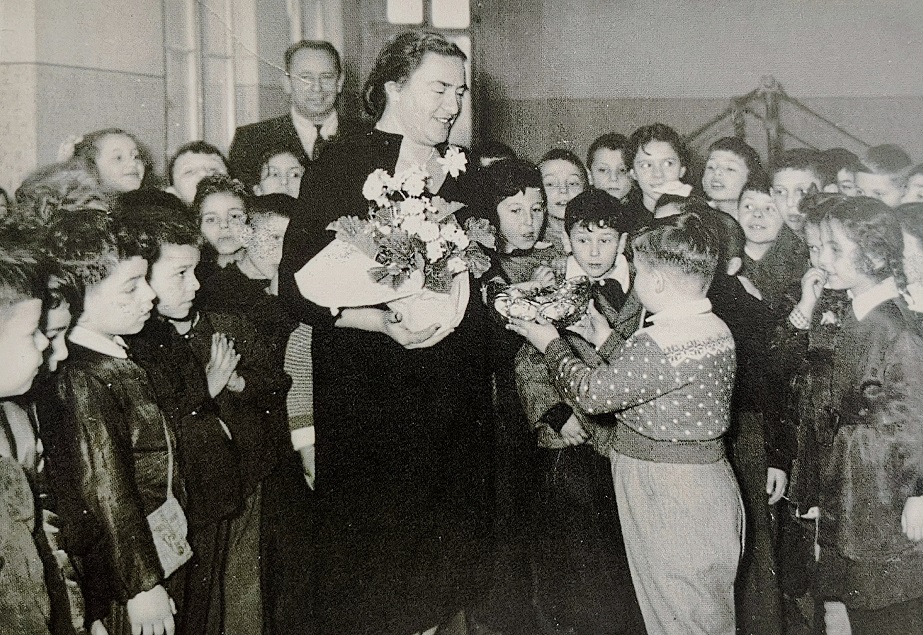The Jewish education system in the post-war period in Poland was a specific and complex aspect of social life of the Jewish minority. The shape of education was subjected to the influence of communist policies, demographic changes, migration and assimilation processes.
Shortly after the end of World War II, Jewish social organisations were taking steps in order to reconstruct the education system. The pivotal role in the process was played by the Central Committee of Jews in Poland which was established in 1944. In the second half of 1940s, a number of secular schools using Yiddish as the language of instruction started to operate. At the same time, At the same time, the so-called cheder schools developed alongside religious groups and Jewish congregations.
At the end of 1949, secular schools were taken over by the communist state and incorporated into the educational system of the communist Poland. The process nearly coincided with the emergence of the Social and Cultural Association of Jews in Poland [i.e. TSKŻ]. Ever since its inception, TSKŻ had supported Jewish education, even though Jewish schools were no longer managed by social organisations. From that moment on, teaching was conducted according to the Ministry of Education’s curriculum, with additional Yiddish classes and elements of Jewish culture.

Jewish education faced numerous organisational, financial and political problems. Despite constant demands from the Jewish minority community, the authorities only partially complied with these demands, and did so with great reluctance. The lack of teaching materials was a problem, but an even greater challenge for school principals was the declining number of pupils.
The emigration processes in 1950s, which were often politically motivated, resulted in the weakening of Jewish education and led to its institutional destabilisation. In 1956, a new subject called “religion” appeared in the national curriculum. This strongly discouraged Jewish parents from sending their children to certain institutions. For some Jewish facilities, it was a last resort to increase their number of students.

In reality, however, class sizes were getting smaller and smaller, as the number Jewish schoolchildren started to shrink. In order to salvage educational facilities, TSKŻ consented to admission of children of Greek communists who sought asylum in Poland. School principals also agreed to create classes dedicated exclusively for children coming from Polish families. At first TSKŻ opposed to such practices, out of concern that Jewish schools would lose their unique character. However, the pressures from the authorities made a compromise necessary.
Despite shortage of pupils, and reduction of teaching jobs, the Jewish community did not relinquish its attempts to preserve their own educational network. In the years 1956-1968, Jewish youth attended vocational schools run by the Organisation for the Development of Industrial, Craft and Agricultural Creativity among the Jewish Population in Poland (ORT). The curriculum included not only general subjects, but also elements of ideological education. In addition, TSKŻ children’s and youth clubs hosted various interest groups, workshops and educational activities.

A biology class. The Source: TSKŻ
Although learning Yiddish was not ostracised by the authorities, it gradually began to disappear as early as the 1954/1955 school year. This decision was based on parents’ preferences and better knowledge of Polish among children. Life itself caused Polish to dominate – recalls Marek Web, a historian and journalist – At first, we were taught Jewish studies every day, then three times a week, and later only two hours a week. Over the years, Yiddish was taught only to a limited extent – not as a living language, but as part of tradition.


End-of-schoolyear ceremony in Wałbrzych. The Source: TSKŻ
Jewish education reflected the broader problems faced by national minorities in a communist state. The initial period of autonomy was quickly replaced by centralisation and subordination to ideology. As a result of the wave of emigration in March 1968, all Jewish institutions were closed down. The legacy of this period survives only in the memories of former students and in the activities of the Lauder-Morash School in Warsaw and the Lauder-Etz Chaim School in Wrocław, both established after 1989.
In the next article, we will be looking closer at TSKŻ’s operations after the systemic transformation in Poland.
By Marta Rydz


The project was implemented thanks to a grant from the Minister of Internal Affairs and Administration.

